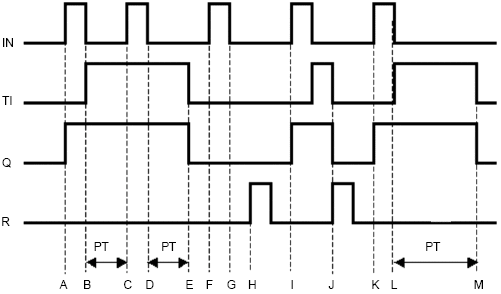

Point A
When IN (input) turns ON, Q (output) turns ON.
Point B
When IN (input) is OFF, TI (timer measurement) turns ON. When TI turns ON, the timer measurement starts.
Point C
When IN (input) turns ON, the timer measurement pauses.
Point D
When IN (input) turns OFF, the paused timer measurement continues.
Point E
When the preset time (PT) value has increased to the point that PT equals ET, TI (timer measurement) and Q (output) turn OFF.
Point F, G
Even if IN (input) turns either ON or OFF, Q (output) and TI (timer measurement) will not turn ON.
Point H
Turning ON R resets the accumulative timer. The timer is reset when an upward transition is detected.
Point I
When IN (input) turns ON, Q (output) turns ON.
Point J
When R (reset) turns on, Q (output) and TI (timer measurement) are reset. The timer current value ET is also reset and cleared to 0.
Point K
When IN (input) turns ON, Q (output) turns ON.
Point L
When IN (input) is OFF, TI (timer measurement) turns ON. When TI turns ON, the timer measurement starts.
Point M
When the preset time (PT) value has increased to the point that PT equals ET, TI (timer measurement) and Q (output) turn OFF.